CHEVROLET MONTE CARLO 1996 5.G Owners Manual
Manufacturer: CHEVROLET, Model Year: 1996, Model line: MONTE CARLO, Model: CHEVROLET MONTE CARLO 1996 5.GPages: 340, PDF Size: 17.79 MB
Page 211 of 340
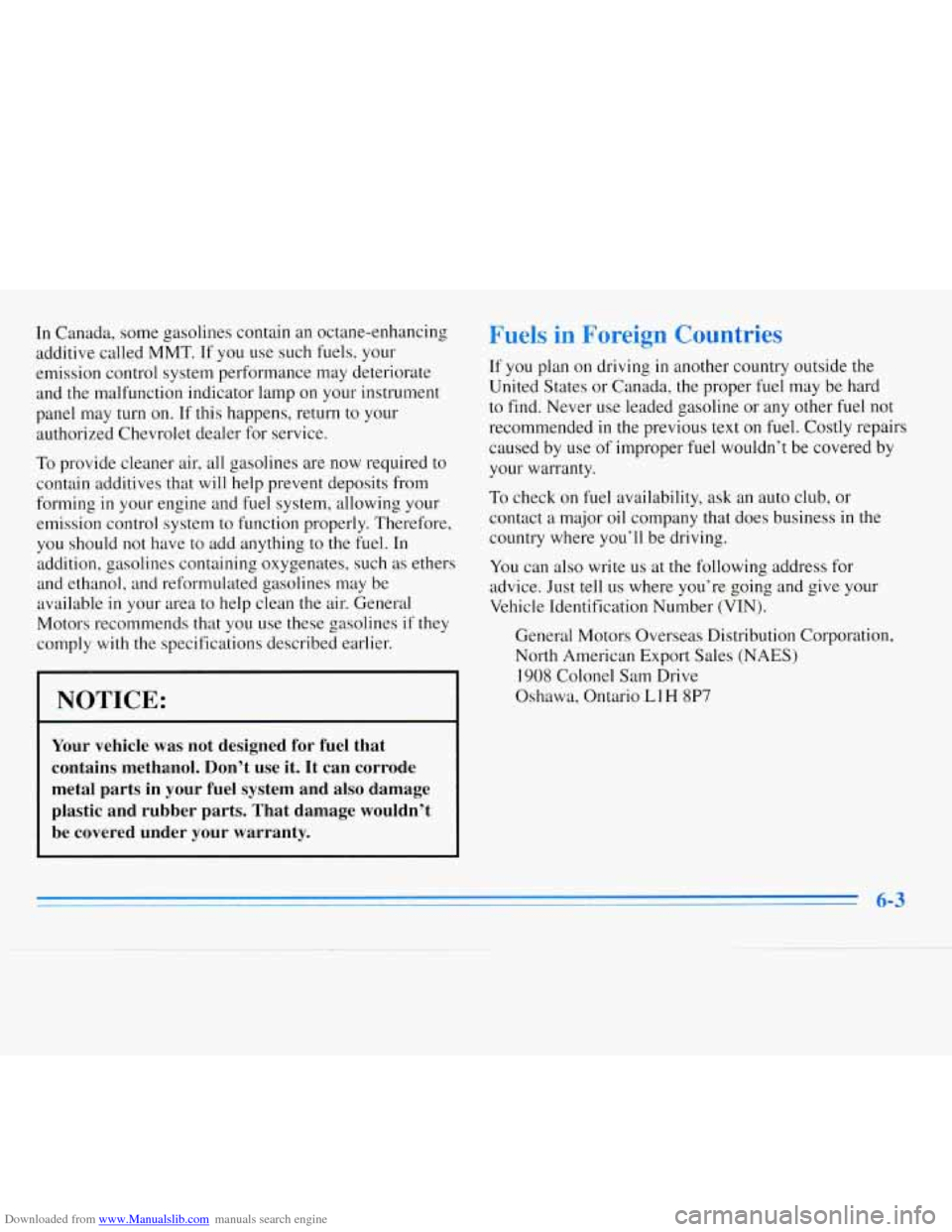
Downloaded from www.Manualslib.com manuals search engine In Canada, some gasolines contain an octane-enhancing
additive called
MMT. If you use such fuels, your
emission control system performance may deteriorate
and the malfunction indicator lamp on your instrument
panel may turn on. If this happens, return to your
authorized Chevrolet dealer for service.
To provide cleaner air, all gasolines are now required to
contain additives that will help prevent deposits from
forming
in your engine and fuel system, allowing your
emission control system to function properly. Therefore,
you should not have to add anything to the fuel. In
addition, gasolines containing oxygenates, such
as ethers
and ethanol, and reformulated gasolines may be
available in your area to help clean the air. General
Motors recommends that you use these gasolines if they
comply
with the specifications described earlier.
NOTICE:
Your vehicle was not designed for fuel that
contains methanol. Don’t use it. It can corrode
metal parts in your fuel system and also damage
plastic and rubber parts. That damage wouldn’t be covered under your warranty.
Fuels in Foreign ‘loun
If you plan on driving in another country outside the
United States or Canada, the proper fuel may be hard
to find. Never use leaded gasoline or any other fuel not
recommended in the previous text on fuel. Costly repairs
caused by use of improper fuel wouldn’t be covered by
your warranty.
To check on fuel availability, ask an auto club, or
contact a major oil company that does business in the
country where you’ll be driving.
You can also write us at the following address for
advice. Just tell us where you’re going and give your
Vehicle Identification Number (VIN).
General Motors Overseas Distribution Corporation,
North American Export Sales (NAES)
1908 Colonel Sam Drive
Oshawa, Ontario LlH
8P7
6-3
Page 212 of 340
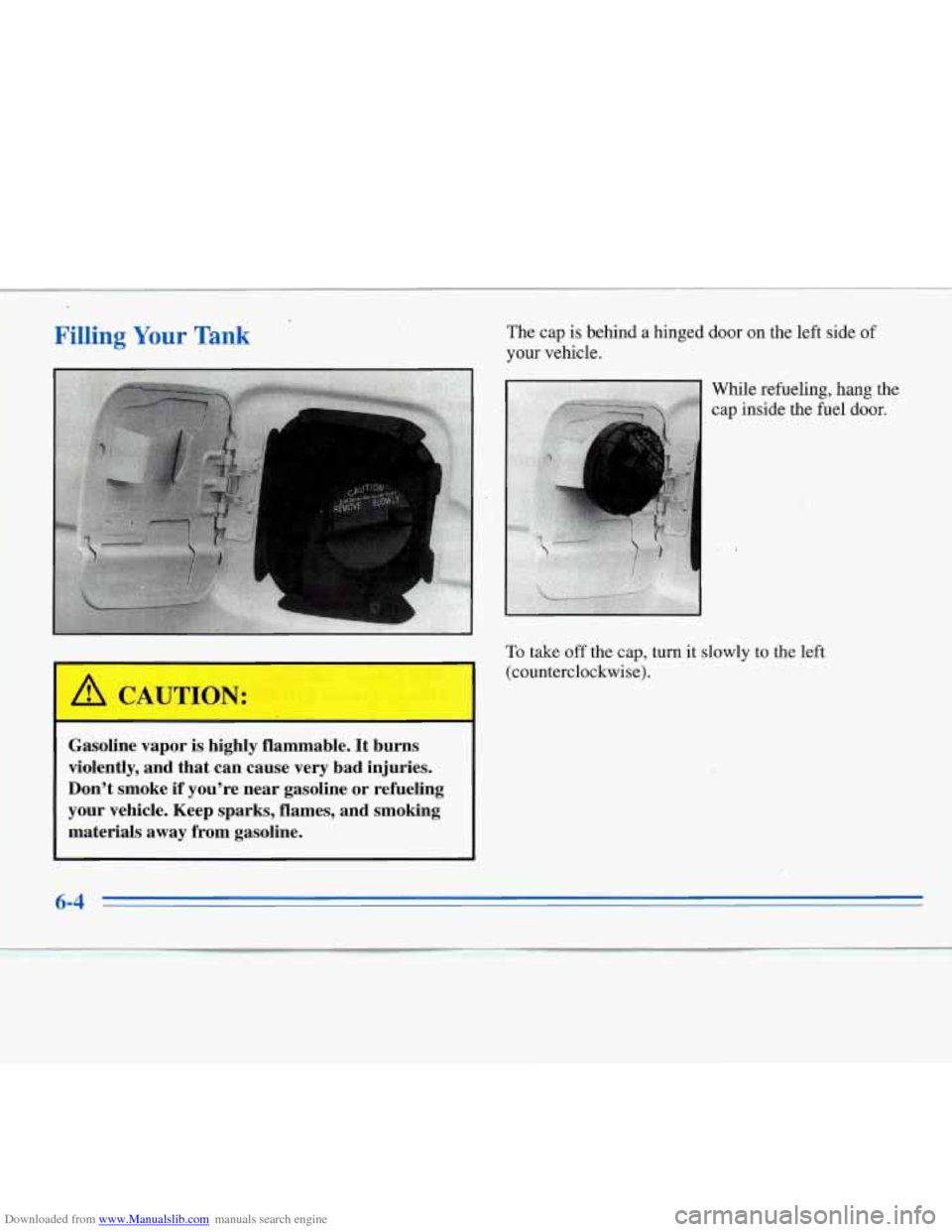
Downloaded from www.Manualslib.com manuals search engine Filling Your Tank
I
The cap is behind a hinged door on the left side of
your vehicle.. While
refueling; hang tbe
cap inside the fuel door.
To take off the cap, turn it slowly to the left
(counterclockwise).
: Gasoline vapor is highly flammable. It burns
violently, and that can cause very bad injuries.
Don’t smoke if yousre near gasoline or reheling
your veh;ieIe. Keep sparks, flames, and smoking
materials away from gasoline.
6-4
Page 213 of 340
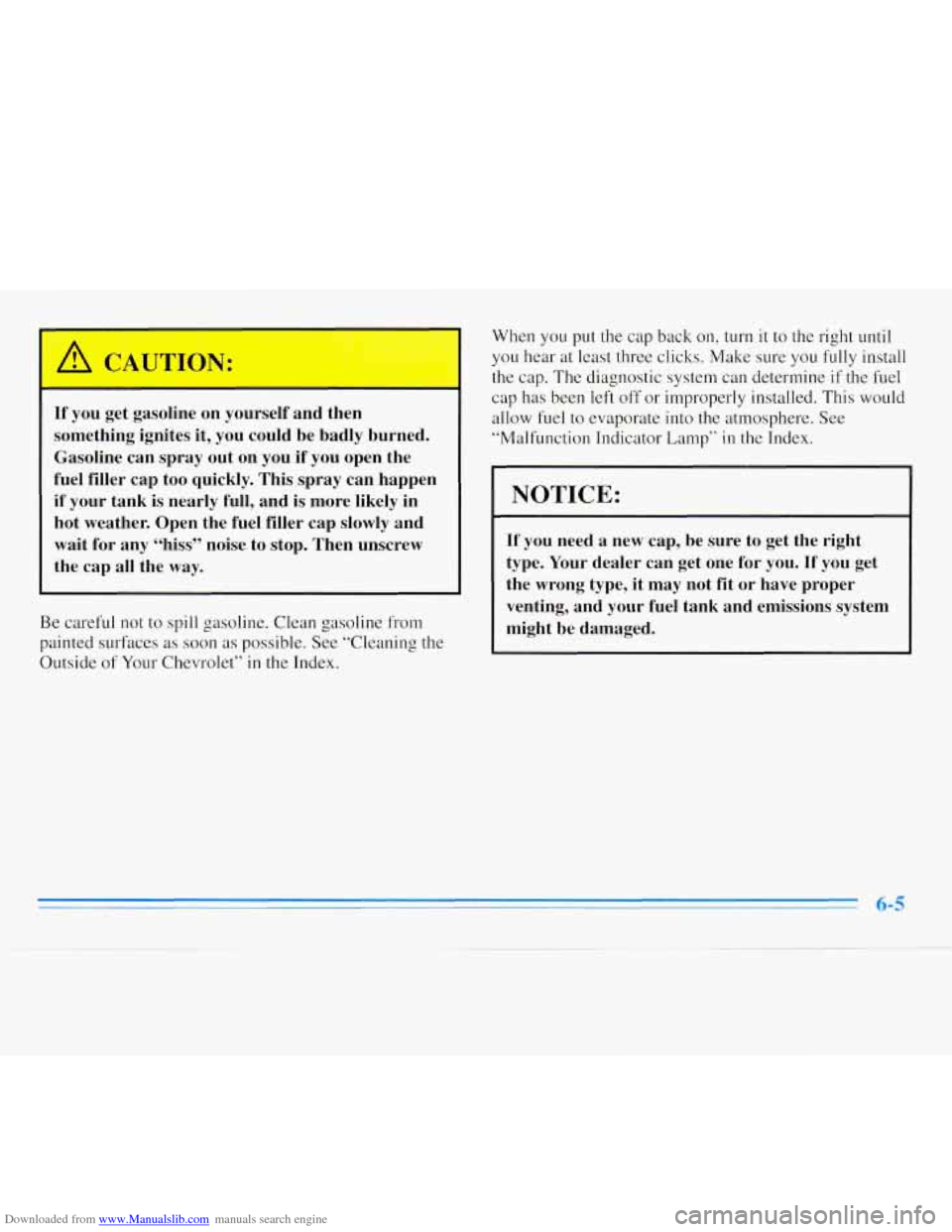
Downloaded from www.Manualslib.com manuals search engine If you get gasoline on yourself and then
something ignites it, you could be badly burned.
Gasoline can spray out on you if you open the
fuel filler cap too quickly. This spray can happen
if your tank is nearly full, and is more likely in
hot weather. Open the fuel filler cap slowly and
wait for any “hiss” noise to stop. Then unscrew
the cap
all the way.
Be careful not to spill gasoline. Clean gasoline from
painted surfaces as
soon as possible. See “Cleaning the
Outside
of Your Chevrolet” in the Index. When
you
put the cap back on, turn it to the right until
you hear at least three clicks. Make sure you
fully install
the cap. The diagnostic system can determine
if the fuel
cap has been left
off or improperly installed. This would
allow fuel
to evaporate into the atmosphere. See
“Malfunction Indicator Lamp”
in the Index.
NOTICE:
If you need a new cap, be sure to get the right
type. Your dealer can get one for you.
If you get
the wrong type, it may not fit or have proper
venting, and your fuel tank and emissions system
might be damaged.
6-5
Page 214 of 340
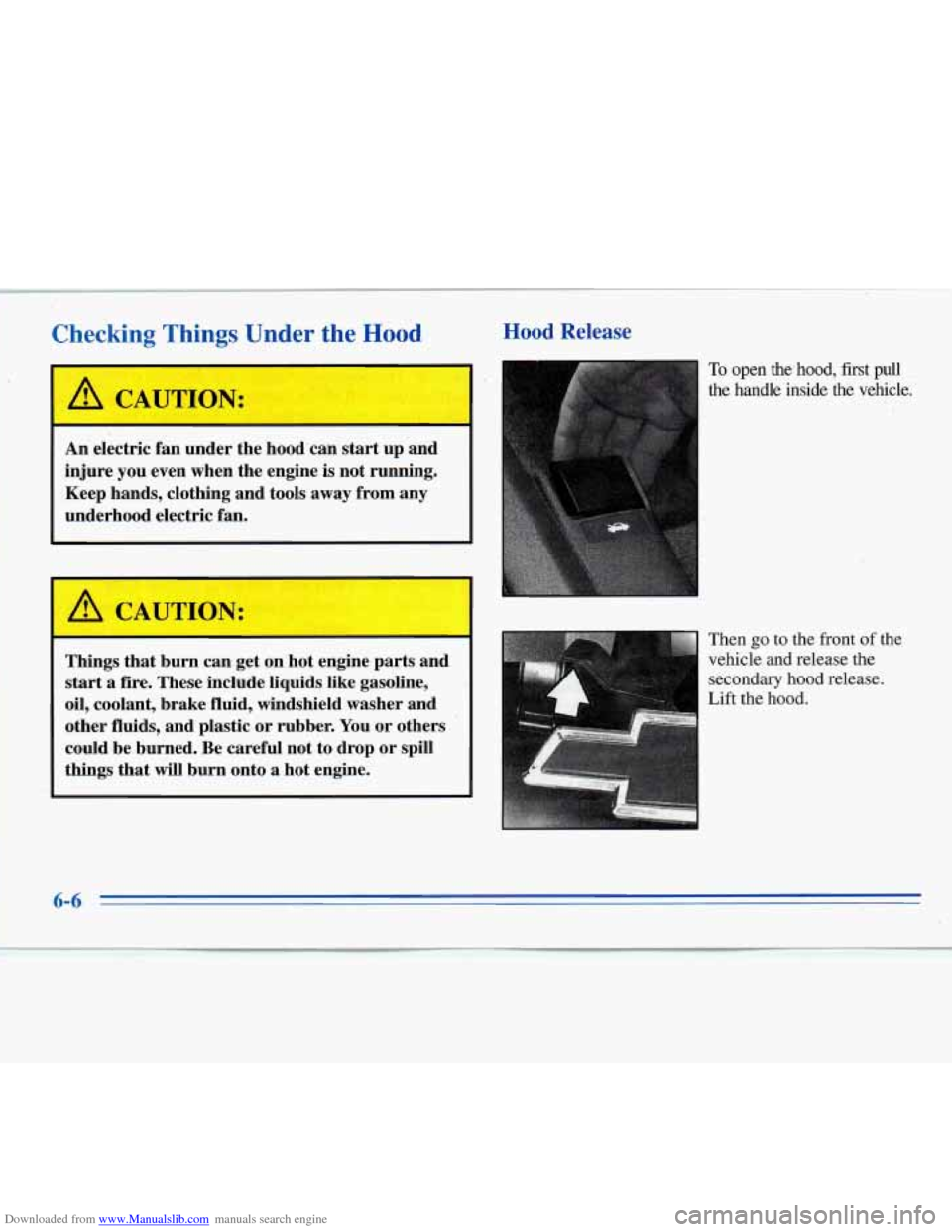
Downloaded from www.Manualslib.com manuals search engine Checking Things Under the Hood
An' electric fan under the hood'can' start up and
injure you even when the engine
is not running.
Keep hands, clothing and tools away from any
underhood electric fan.
I
Things that burn can get on hot engine parts and
start
a fire. These include liquids like gasoline,
oil, coolant, brake fluid, windshield washer and
other fluids, and plastic or rubber. You or others
could be burned. Be careful not to drop or spill
things that will burn onto a hot engine.
Hood Release
To open the'hood, first pull
the handle inside the vehicle.
Then
go to the front of the
vehicle and release the secondary hood release.
Lift the hood.
6-6 -
Page 215 of 340
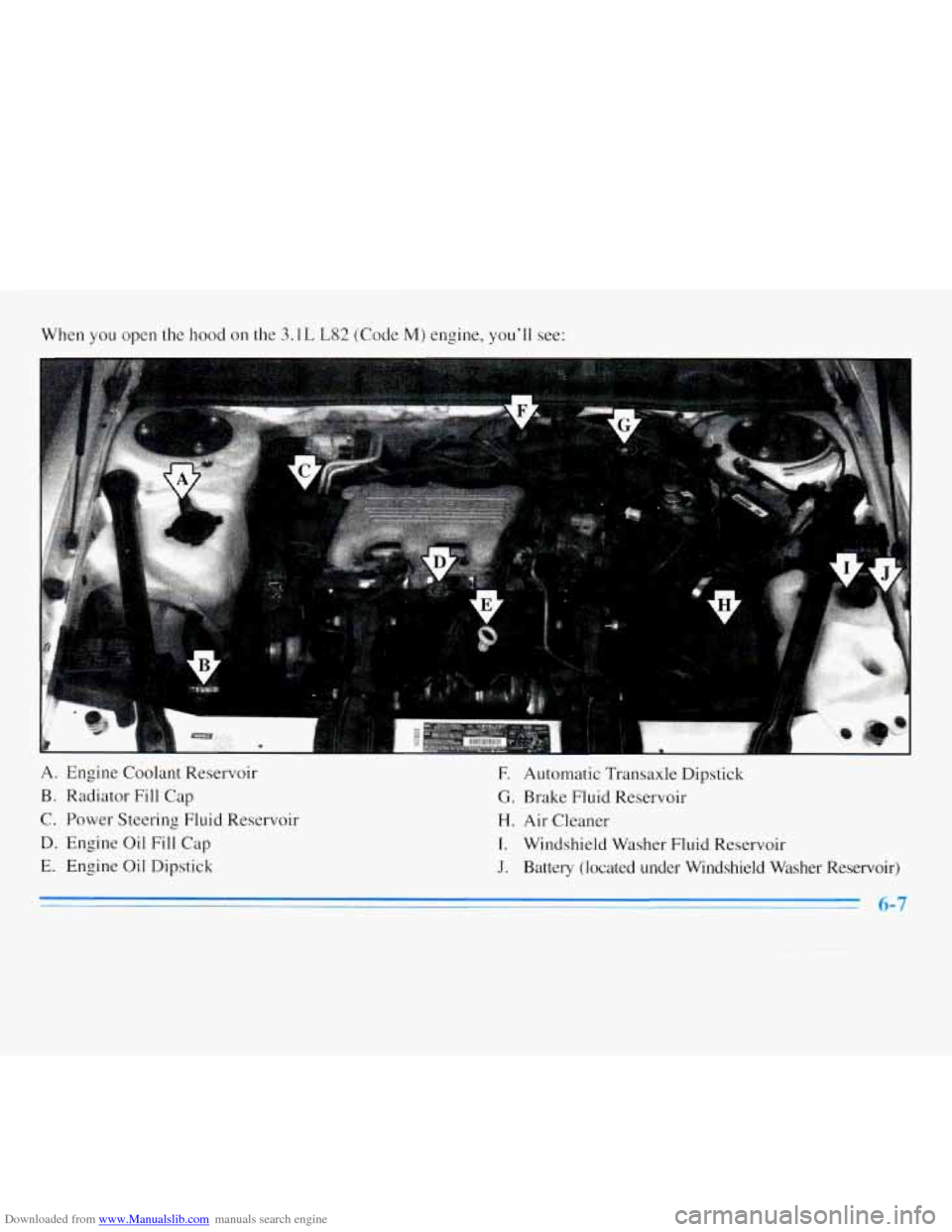
Downloaded from www.Manualslib.com manuals search engine When you open the hood on the 3.1 L L82 (Code M) engine, you’ll see:
A. Engine Coolant Reservoir
B. Radiator Fill Cap
C. Power Steering Fluid Reservoir
D. Engine Oil Fill Cap
E. Engine
Oil Dipstick
E Automatic Transaxle Dipstick
G. Brake Fluid Reservoir
H. Air Cleaner
I. Windshield Washer Fluid Reservoir
J. Batte~y (located under Windshield Washer Reservoir)
Page 216 of 340
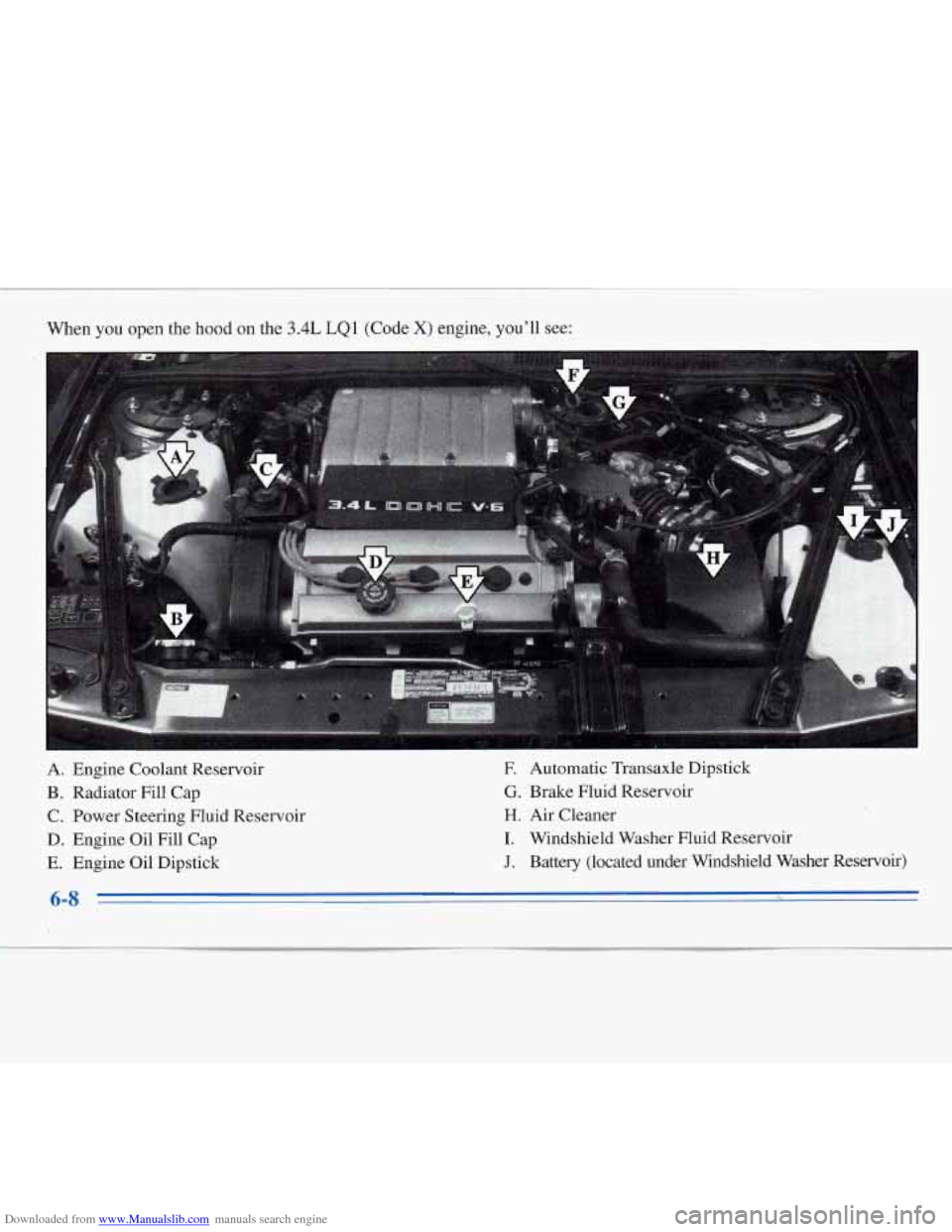
Downloaded from www.Manualslib.com manuals search engine !i
When you open the hood on the 3.4L LQ1 (Code X) engine, you’ll see:
A. Engine Coolant Reservoir
B. Radiator Fill Cap
C. Power Steering Fluid Reservoir
D. Engine Oil Fill Cap
E. Engine Oil Dipstick
E Automatic Transaxle Dipstick
G. Brake Fluid Reservoir
H. Air Cleaner
I. Windshield Washer Fluid Reservoir
J. Battery (located under Windshield Washer Reservoir)
6-8 II
Page 217 of 340
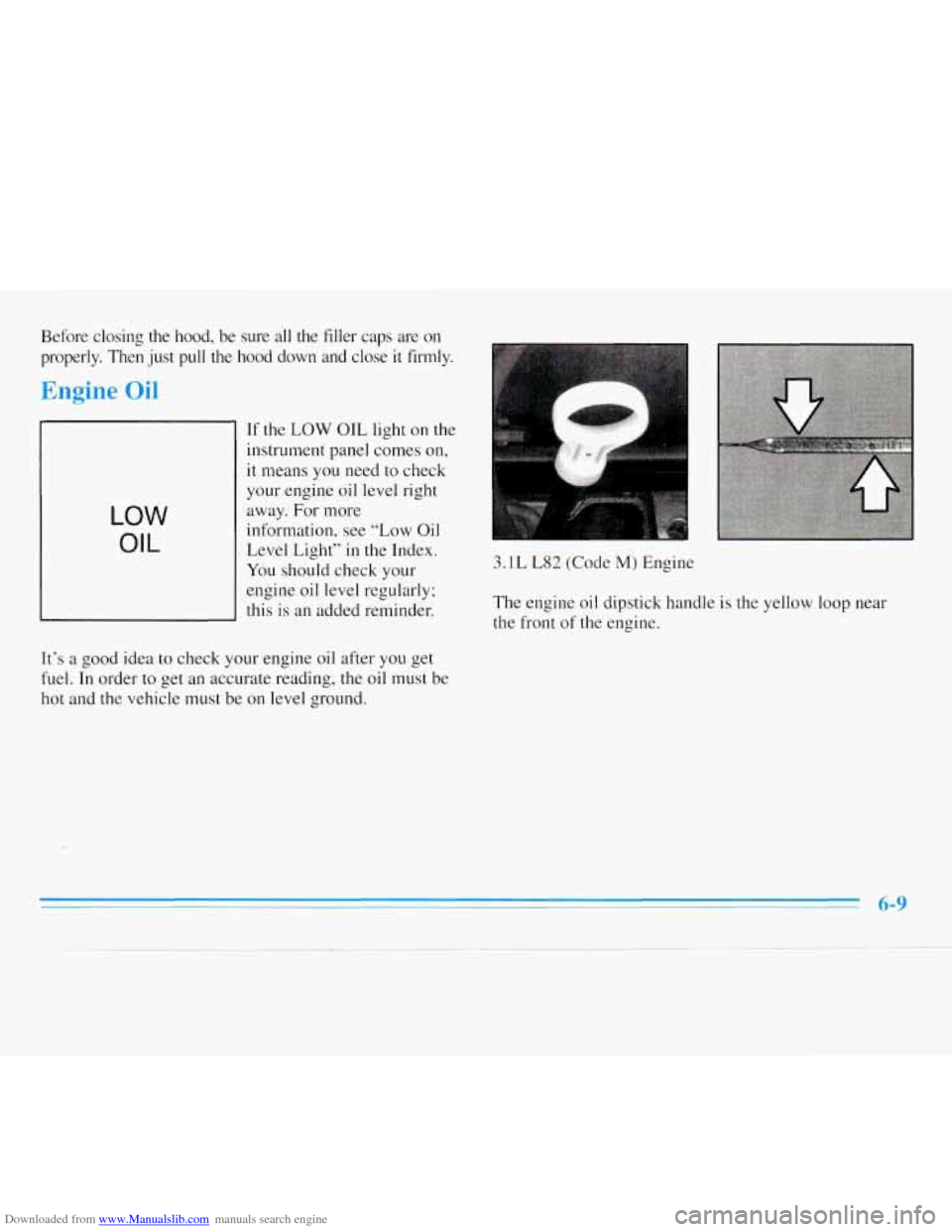
Downloaded from www.Manualslib.com manuals search engine Before closing the hood, be sure all the filler caps are on
properly. Then just pull
the hood down and close it firmly.
Engine Oil
LOW
OIL
If the LOW OIL light on the
instrument panel comes on,
it means
you need to check
your engine oil level right
away. For more
information, see “Low Oil
Level Light”
in the Index.
You should check your
engine oil level regularly;
this is an added reminder.
It’s a good idea to check your engine
oil after you get
fuel. In order to get an accurate reading, the oil must be
hot and the vehicle must be on level ground.
3.1 L L82 (Code M) Engine
The engine
oil dipstick handle is the yellow loop near
the front
of the engine.
6-9
Page 218 of 340
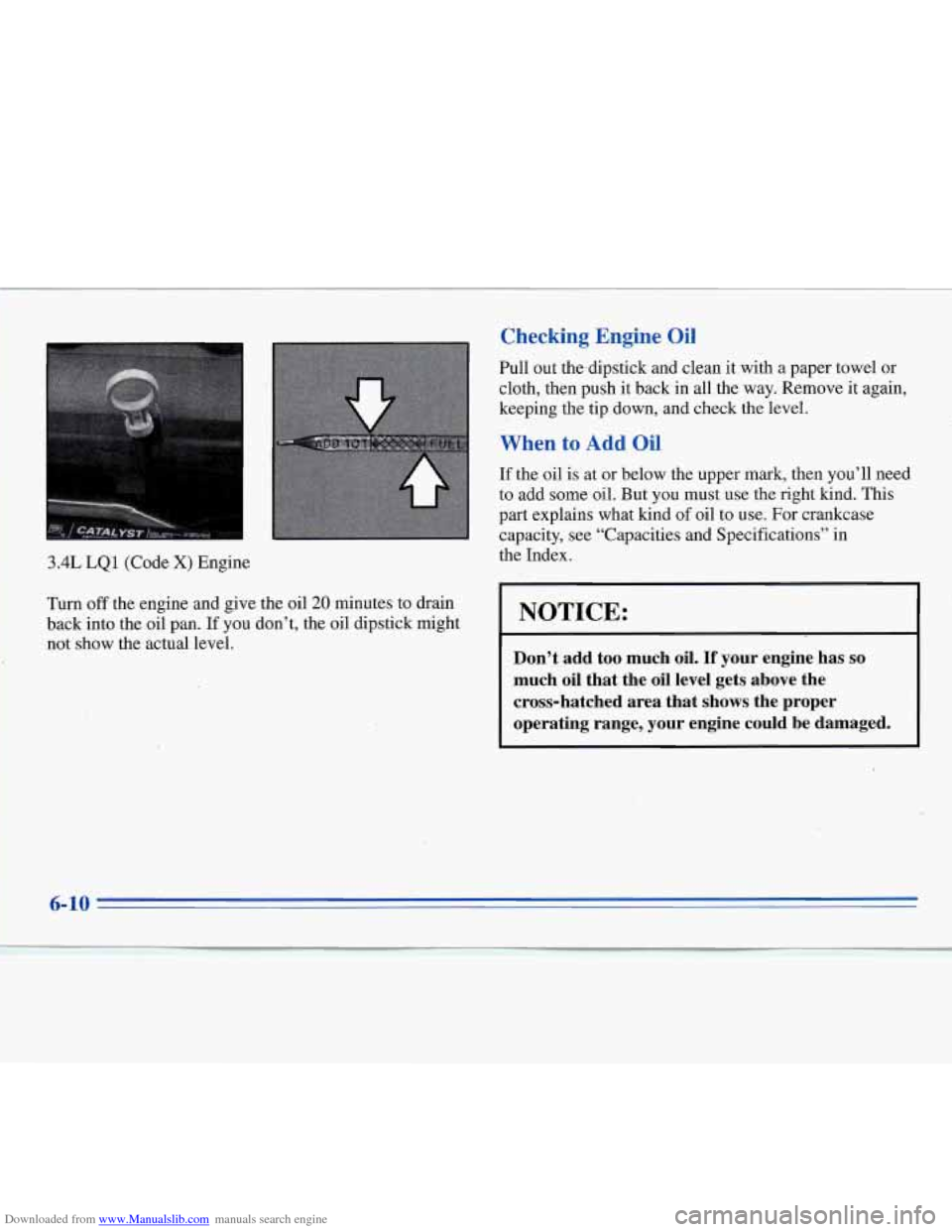
Downloaded from www.Manualslib.com manuals search engine ,/ : t
I
I
3.4L LQ1 (Code X) Engine
Checking Engine Oil
Pull out the,dipstick and clean it with a paper towel or
cloth, then push it back in all the way, Remove it again,
keeping the tip down, and check the level.
When to Add Oil
If the oil is at or below the upper mark, then you’ll need
to add some oil. But you must use the right kind. This
part explains what kind of oil to use. For crankcase
capacity, see “Capacities and Specifications” in
the Index.
Turn
off the engine and give the oil 20 minutes to drain
back into the oil pan. If you don’t, the oil dipstick might
not show the actual level. NOTICE:
Don’t add too much oil. If your engine’has SO
much oil that the oil level gets above the
cross-hatched area that shows the proper
operating range, your engine could be damaged.
6-10
Page 219 of 340
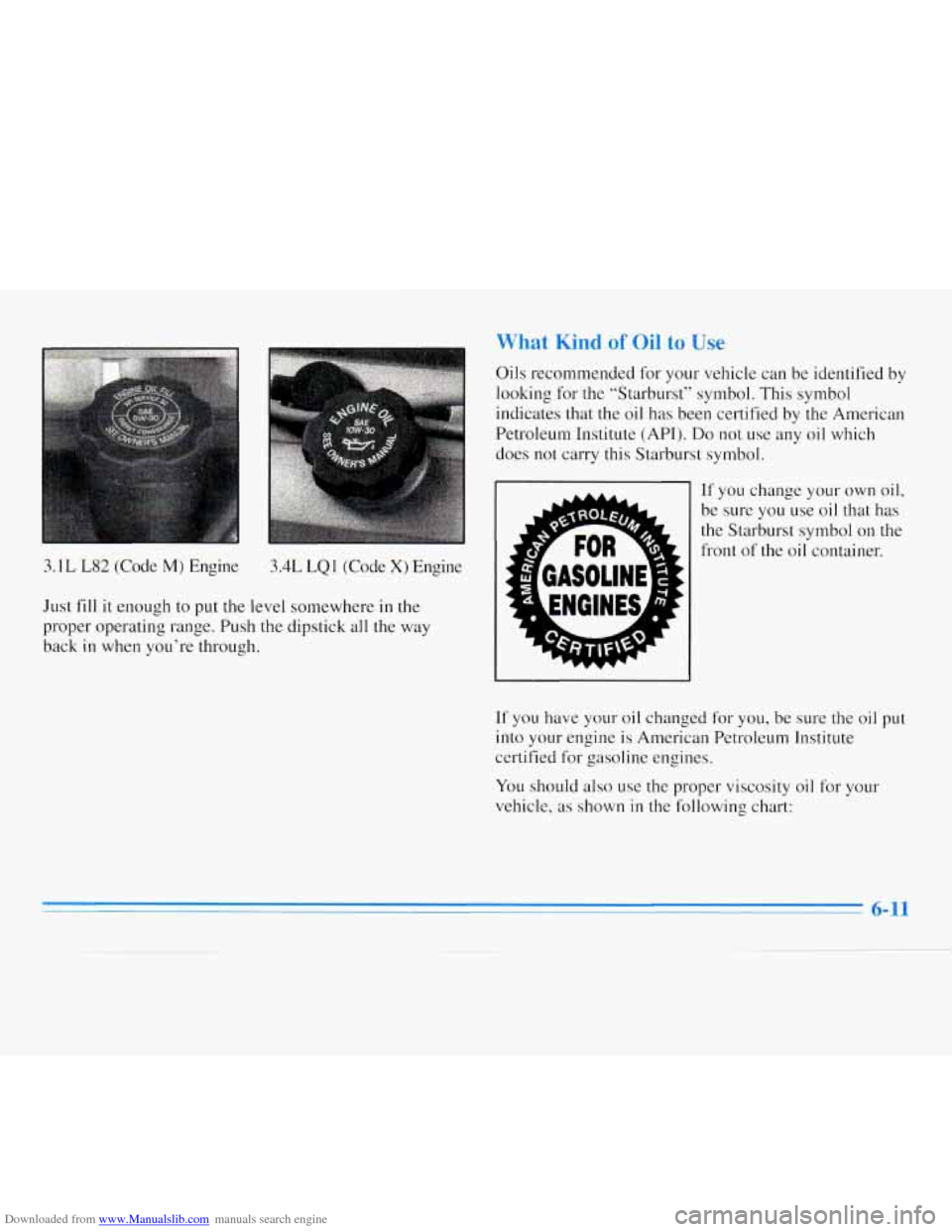
Downloaded from www.Manualslib.com manuals search engine : Kind of Oil to
Oils recommended for your vehicle can be identified by
looking for the “Starburst” symbol. This symbol
indicates that the oil has been certified by the American
Petroleum Institute
(API). Do not use any oil which
does not carry this Starburst symbol.
1 If you change your own oil,
i be sure you use oil that has
the Starburst symbol on the
front of the oil container.
3.1
L L82 (Code M) Engine 3.4L LQ 1 (Code X) Engine
Just
fill it enough to put the level somewhere in the
proper operating range. Push the dipstick all the way
back
in when you’re through.
If you have your
oil changed for you, be sure the oil put
into your engine
is American Petroleum Institute
certified
for gasoline engines.
You should also use the proper viscosity oil for your
vehicle, as shown
in the following chart:
6-11
Page 220 of 340
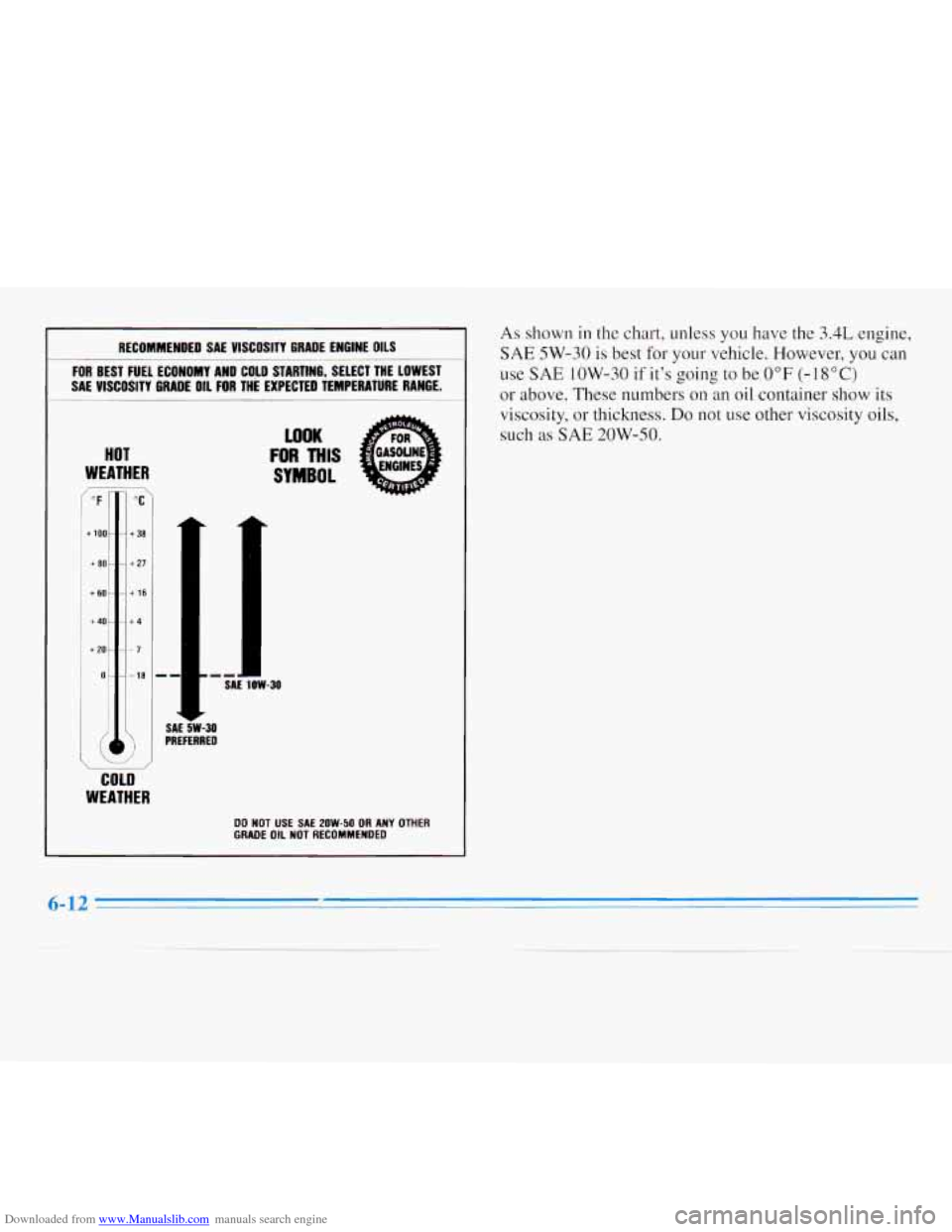
Downloaded from www.Manualslib.com manuals search engine RECOMMENDED SAE VISCOSITY GRADE ENGINE OILS ~~~ ~
FOR BEST FUEL ECONOMY AND COLD STARTING, SELECT THE LOWEST
SAE VISCOSITY GRADE OIL
FOR THE EXPECTED TEMPERATURE RANGE.
HOT
WEATHER
“F
k 100-
+ 80 -
+ 60 -
+ 40 -
+ 20.
0-
i
7
“C
. + 38
- + 27
- + 16
- +4
--7
--18
LOOK
FOR THIS
SYMBOL
SAE 1OW-30
SAE gW-30 PREFERRED
COLD
WEATHER
DO NOT USE SAE 2OW-50 OR ANY OTHER GRADE OIL NOT RECOMMENDED
As shown in the chart, unless you have the 3.4L engine,
SAE
5W-30 is best for your vehicle. However, you can
use SAE
1OW-30 if it’s going to be 0°F (-18°C)
or above. These numbers on an oil container show its
viscosity,
or thickness. Do not use other viscosity oils,
such
as SAE 20W-50.